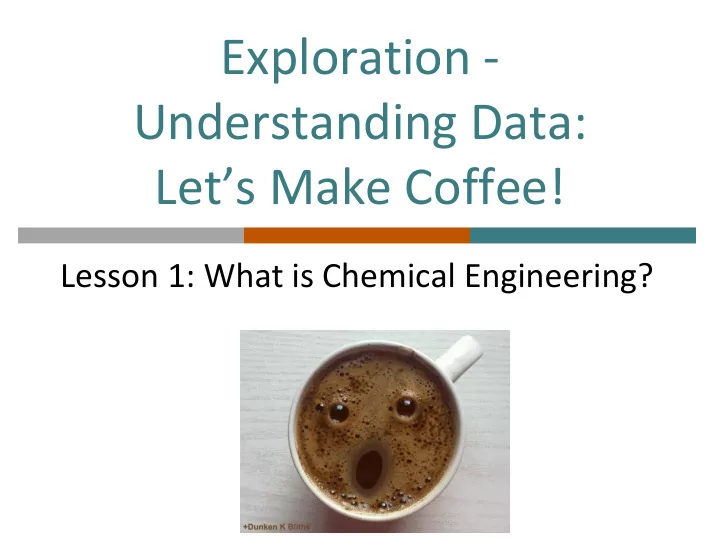

Exploration - Understanding Data: Let’s Make Coffee! Lesson 1: What is Chemical Engineering?
What is Chemical Engineering? What are some things that you think chemical engineers do? Where do you think chemical engineers work?
Meet Melanie, Chemical Engineer
Assignment: Presentation on chemical engineering Research and describe a specific technology , product , project , or job related to chemical engineering today. Each team will focus on a different field. Air and Water Quality Industrial Safety and Operations Agriculture Materials Engineering Cell and Tissue Engineering Nanotechnology Computing Nuclear Engineering Energy Pharmaceuticals Foods Sustainability, Reuse, and Forest Bioproducts Recycling Fuels and Petrochemicals
There are different types of chemical engineers. Two of the most common (but not the only) categories of chemical engineers are Process Engineers , who design and operate plants and machinery relating to industrial processes Product Engineers , who develop new or updated materials, chemicals, or products Many chemical engineers focus on making processes or products safer, more efficient, and more economical.
Can brewing coffee be a chemical engineering challenge? What happens when you brew coffee? How can you brew strong coffee? Think (2 minutes): Given whole coffee beans and water, what could you do to make strong coffee ? List these in your engineering notebook. Pair (2 minutes): Compare answers with your team mates. Add to the list in your engineering notebook. Share: We will generate a class list of ideas. Add to the list in your engineering notebook.
How can we measure coffee “strength”? Given a cup of coffee, how can you tell how “strong” it is? What does it look, taste, smell, or feel like as compared to a “weak” cup of coffee? Are there any quantities you can measure to quantify a cup of coffee as “strong” or “weak”? In your groups, think of at least two quantitative and two qualitative ways to analyze coffee strength. Note these in your engineering notebooks.
What are potential qualitative and quantitative test methods? Quantitative Test Methods involve measuring specific quantities and ensuring measurements match desired set points Examples: pH, concentration, viscosity, density Qualitative Test Methods compare qualitative observations to expected characteristics Examples: color, taste, smell, visual appearance
The chemistry of brewing coffee What happens chemically when coffee grounds are placed in water? Thousands of different compounds are extracted from the coffee grounds into the water. These compounds are responsible • for qualities such as aroma , acidity , taste , color , and concentration of caffeine . The rate and amount of extraction • of these compounds is dependent on factors such as the size of the coffee grain , the temperature of the water that the coffee is placed in, and the amount of coffee grain present.
Concocting the Perfect Cup of Coffee (Courtesy of Science Friday ) http://sciencefriday.com/video/04/12/2013/concocting-the-perfect-cup-of-coffee.html
The chemistry of brewing coffee Here are a few of the compounds that get extracted from coffee grounds.
Measuring Concentration Molecules that are formed in the coffee brewing process produce ions. From chemistry we know that migration of ions produces an electrical current (conductivity). The higher the amount of ions in a solution, the higher the conductivity of the solution. Conductivity can therefore be used as a measure of concentration. Higher conductivity stronger coffee
Notebook Check Place post-it notes on the appropriate pages in your notebook to denote the following items: Chemical Engineering Professions Research Assignment Notes from Think-Pair-Share Qualitative and Quantitative Measurement Methods Write down the name of the appropriate item on each post-it. Place a post-it in your notebook for anything else you are particularly proud of or would like me to see.
Homework and What’s Next Be working on your research project into chemical engineering fields and professions. Next time, we will explore how a chemical engineer might approach brewing “the perfect cup of coffee”.
Recommend
More recommend